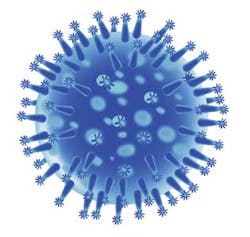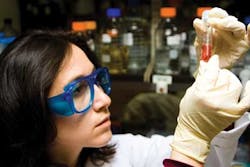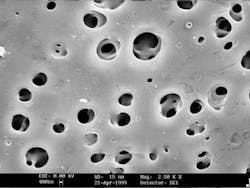Tiny Treatment, Big Solutions: Nanoscience Offers Potential to Enhance Water Purification Techniques
By Art Haddaway, WaterWorld Editor
What can we glean from nanotechnology? That's the ultimate question many industry professionals have been asking lately as new developments in nanoscience continue to emerge in the area of water and wastewater treatment.
Once considered a farfetched notion, nanotechnology is now a reality and is starting to be incorporated into myriad treatment applications including membranes and adsorbents as well as processes like desalination and coagulation. Moreover, these nanoscale materials are revolutionizing the way water and wastewater is purified across the industry.
In a recent article from Nanowerk (www.nanowerk.com), an online organization specializing in the study of nanosciences, nanotechnologies and other emerging technologies, Professor Eugene Cloete, vice rector of research and innovation at the University of Stellenbosch, explained there are three focal areas of water purification that are being influenced by nanomaterials: pollutant remediation, detection and prevention.
"Within the category of treatment and remediation, nanotechnology has the potential to contribute to long-term water quality, availability and viability of water resources, such as through the use of advanced filtration materials that enable greater water reuse, recycling and desalinization," he said. "Within the category of sensing and detection, of particular interest is the development of new and enhanced sensors to detect biological and chemical contaminants at very low concentration levels in the environment, including water."
According to the National Nanotechnology Initiative, a federal research and development program, nanotechnology is described as the engineering of matter at the molecular scale with dimensions of roughly 1 to 100 nanometers. This practice provides researchers the ability to manipulate and control individual molecules more proficiently, in that the segments of those particles grow larger as the methods of research get smaller. Thus, "the more surface area you have, the more efficient potentiality you have for your treatment," explained Todd Kuiken, senior research associate at Woodrow Wilson International Center for Scholars.
"That's important for chemical reaction - the more surface area, the more space you have for a chemical reaction to occur," he said. "When you're talking about water purification or water treatment, you're talking about chemistry."
One of the main concentrations in the development of nanotechnology in recent years has been filtration, particularly relating to membranes. Already being used in a vast array of water and wastewater applications, these viable structures have contributed to some of the industry's most effective treatment methods with their ability to effectively separate and filter suspended solids and other roaming contaminants on a miniature level. Further, scientists are looking more toward membrane-based systems as a prototype for the capabilities of nanotechnology. "Chief among these is the use of filters fabricated with nanoscale materials that produce pores down to the molecular level," said Jeff Keller, senior project manager at Burns & McDonnell.
Keller explained that this new architecture could provide lower frictional resistance in filtration processes, significantly reducing the energy requirements and costs of treating water and wastewater. "The traditional way to make membranes is currently at the macro scale - you don't define exactly how straight or curved or loopy each one of those pores is in the membrane, and that makes it very energy intensive. But if you could make a membrane that has very straight paths, you can make those products behave better at a lower energy cost and a higher level of efficiency."
According to Nanowerk's article, the two types of filtration-based applications produced by molecular science that are contributing to its future development are nanostructured filters that utilize either carbon nanotubes or nanocapillary arrays, as well as nanoreactive membranes that employ functionalized nanoparticles. The advantages of integrating these upgraded systems provide industry professionals "opportunities to refine as well as to develop effective filtration processes for purification of water contaminated by different organic solutes and inorganic anions."
Another application favorable to nanotechnology is adsorbents. Primarily used to adhere, enrich or remove chemicals - such as arsenic and other metal pollutants - in gas or liquid on the surface of a solid, these structures are widely accepted in the industry as a quick and inexpensive method of treatment for both water and wastewater. Like membranes, adsorbents also operate on a miniature scale, providing users a seamless solution when retrofitted with new nanomachinery.
Adsorbents comprise both organic and inorganic materials that aid in the purification process. Organics of either synthetic or natural elements consist of activated carbons, polymers and biomass; and inorganics contain minerals such as aluminas, silicas and zeolites, as described in a study by Adsorption Research Inc. It's these compounds along with many others that are starting to be augmented by the presence of nanotechnology.
"Nanomaterials exhibit key physicochemical properties that make them particularly attractive as high capacity and selective adsorbents for water treatment," said Mamadou Diallo, joint professor of the Korea Advanced Institute of Science and Technology (KAIST) and the California Institute of Technology (Caltech). "They can increase their affinity toward compounds including dissolved solutes such as toxic metal ions and organic pollutants. This is how nanostructuring allows you to achieve better performance."
Keller added, "By knowing how the nanoscale works, we can make much more efficient absorbents that target certain types of pollutants that we couldn't do before, and it allows us to treat water better, treat water more cheaply and treat water faster than we have in the past, and those kinds of products are starting to show up out there."
As a whole, the development of nanotechnology in membranes, adsorbents and other filtration techniques is starting to grow and be increasingly utilized across the water sector. Diallo clarified, "In my research, we're developing nanotechnology-based adsorbents and ion-exchange resins that have greater performance than commercial materials. And even now, some new reverse osmosis membranes based on nanostructed materials are being commercialized."
Along with membranes and adsorbents, substances like nanocatalysts and nanoporous materials can also aid the water and wastewater treatment process. In all, researchers are finding that nanotechnology can be used in nearly any type of purification process and offers a number of advantages to water professionals and consumers alike looking to utilize its applications.
Owing to its broad and profound fundamentals, nanoscience is a versatile area of discipline. From extracting pollutants in stormwater runoff to removing impurities in industrial sites to singling out contaminants in drinking water and wastewater, nanotechnology can provide far more advanced treatment solutions than traditional processes. "We refer to this as a platform technology because it really does cross all types of fields, so there's not just one specific area you can use nano in," explained Kuiken.
Consequently, nanotechnology has the potential to significantly improve water quality in many areas of the industry. As stated in an article by the South African Water Research Commission, "Nanotechnology is a multi-disciplinary research and development area, bringing together chemists, physicists, biotechnologists, and engineers to work towards improving water quality."
Thembella Hillie, principle research scientist at the National Centre for Nano-Structured Materials, a DST/CSIR nanotechnology innovation center, described that one of the likely key benefits of adopting nanotechnology is how unobstructed the quality of water could be once it's treated. "Most water utilities are in pains to reduce chlorine in their water treatment processes, and nanotechnology can provide complementary solutions in this regard. It has several advantages over conventional water treatment technologies, including high separation efficiency in particular for toxic metals such as arsenic and mercury."
The implementation of nanotechnology also has the potential to conserve water costs with its relatively inexpensive purification methods. Because of their structure and chemistry, "most of these solutions do not need huge investments in infrastructure and require less material costs," mentioned Hillie. Additionally, having better water costs improves the management and monitoring of water resources around the globe. "Nanotechnology can produce alternative water supplies from hitherto unusable water sources, such as brackish water, seawater and various wastewaters, including municipal and industrial effluents," he said. As a result, this can help enhance infrastructure, preserve the environment and improve overall quality of life, particularly in destitute and impoverished nations.
Keller added, "The water quality in different reservoirs and sources of drinking water is going to become much easier and less expensive to process, and so the ability to monitor what's occurring is going to give us a much clearer idea of how our treatment systems are running and the condition of our water resources."
The development of nanotechnology may even provide a better understanding of water itself: the way it's structured, its importance and how it interacts with and affects other chemicals and materials. Because nanoscience operates at an exceptionally sophisticated level, it could enable researchers the ability to observe and understand certain characteristics of water and wastewater they normally can't identify with conventional methods.
While there are many benefits to integrating nanomaterials in water and wastewater treatment, many industry professionals still regard the world of nanotechnology as new, broad and unfamiliar. As with any emerging technology, there are some challenges and uncertainties associated with the preliminary stages of its research and development.
One concern is that, given their small size, large quantities, high toxicity, and rudimentary development, nanomaterials could potentially become a source of pollution themselves, according to an article by the European Commission. As the need for them increases, so does the risk of being able to properly manage them. They can easily get lost in the atmosphere, invade the cells of humans and be misidentified among other contaminants, causing them to be extremely difficult to find and remedy.
Other challenges include the effects of nanomaterials on public health, the environment and local water utilities, as well as the consideration of new regulation requirements to monitor various methods of growth and implementation. Likewise, the promises of nanotechnology are large but the practical developments of it are small.
Nanowerk stated that "a particular problem with nanotechnology lies in the huge gap between the public perception of what the hype promises and the scientific and commercial reality of what the technology actually delivers today and in the near future."
While its dangers aren't yet fully known, emerging nanotechnologies have garnered much attention and support in recent years through new programs and products, and many steps are being taken to advance their presence in the water and wastewater industry.
"This is a fundamentally new branch of science and technology and it will have an impact in the same way that steam or electricity or chemistry itself has impacted society," said Keller. "The potential for it in every industry, and in every aspect of our lives, is tremendous: when you go from doing things and building things at a big, macro scale to doing things at the most fundamental level of nature, it opens up all sorts of possibilities."
About the Author

Art Haddaway
Assistant Editor
Art Haddaway is the Assistant Editor of WaterWorld and Industrial WaterWorld magazines. A writer and editor of over 10 years, he has contributed to a variety of regional publications covering everything from current events to creative features. Art is a graduate of Oral Roberts University in Tulsa, Okla., with a bachelor’s degree in print journalism.



